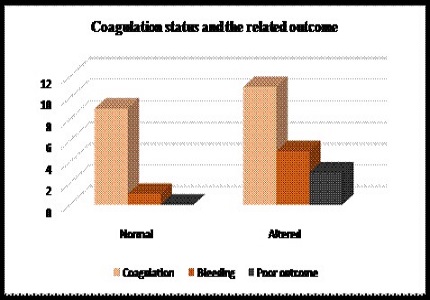Coagulation Profile in Perinatal Asphyxia
Abstract
Introduction: Perinatal asphyxia is a common problem with devastating consequences in neonatal practice. Bleeding due to coagulation abnormality is very common and is potentially treatable. Various mechanisms including liver dysfunction, unresponsiveness to Vitamin K and consumption of coagulation factors all have been implicated in severe bleeding in asphyxiated neonates. The magnitude of this problem and therapeutic window if present has not been well studied.
Methods: this was a prospective study undertaken in a tertiary care centre. 20 babies were recruited for the study. Asphyxia was defined on pragmatic basis of Apgar score and need for resuscitation followed by clinical course. The blood sample was collected in citrated tubes and analysed for coagulation parameters.
Results: 55% of our subjects were having deranged coagulation. APTT was the commonest deranged parameters in all our subjects (11/20). PT was deranged in only 2 of 20 patients. Patients who had deranged coagulation had poor outcomes. Coagulation abnormalities within first 24 hours had a positive predictive value of 18% and negative predictive value of 100% with respect to later bleeding.
Conclusion: Deranged coagulation is very common in asphyxiated neonates and is associated with poor outcome.
Downloads
References
2. Dorothy RB, Michael AS, William EH. Coagulation studies in extremely premature infants. Pediatric research 1979;13:1330–35.
3. Godambe SV, Udani RH, Malik S, Kandalkar BM. Hepatic profile in asphyxia neonatorum. Indian Pediatr. 1997 Oct;34(10):927-30. [PubMed]
4. Chadd MA, Elwood PC, Gray OP, Muxworthy SM. Coagulation defects in hypoxic full-term newborn infants. Br Med J. 1971 Nov 27;4(5786):516-8.
5. Kisker CT, Robillard JE, Clarke WR. Blood coagulation changes after hypoxemia: a fetal lamb model. Pediatr Res. 1982 Jan;16(1):8-12. [PubMed]
6. Appleyard WJ, Cottom DG. Effect of asphyxia on thrombotest values in low birthweight infants. Arch Dis Child. 1970 Oct;45(243):705-7.
7. Hambleton G, Appleyard WJ. Controlled trial of fresh frozen plasma in asphyxiated low birthweight infants. Arch Dis Child. 1973 Jan;48(1):31-5. [PubMed]
8. Watkins MN, Swan S, Caprini JA, Gardner TH, Zuckerman L, Vagher JP. Coagulation changes in the newborn with respiratory failure. Thromb Res. 1980 Jan 1-15;17(1-2):153-75. [PubMed]
9. Ibrahim ZK. Maduhu, Karim P.Manji, Roger L.Mbise. Perinatal risk factors for neonatal bleeding at the Muhimbili national hospital Dar – Es – Sakaam, Tanzania.Tanzania medical journal 2004 Jun;19(2):1-3. [PubMed]

Copyright (c) 2015 Author (s). Published by Siddharth Health Research and Social Welfare Society

This work is licensed under a Creative Commons Attribution 4.0 International License.


 OAI - Open Archives Initiative
OAI - Open Archives Initiative


